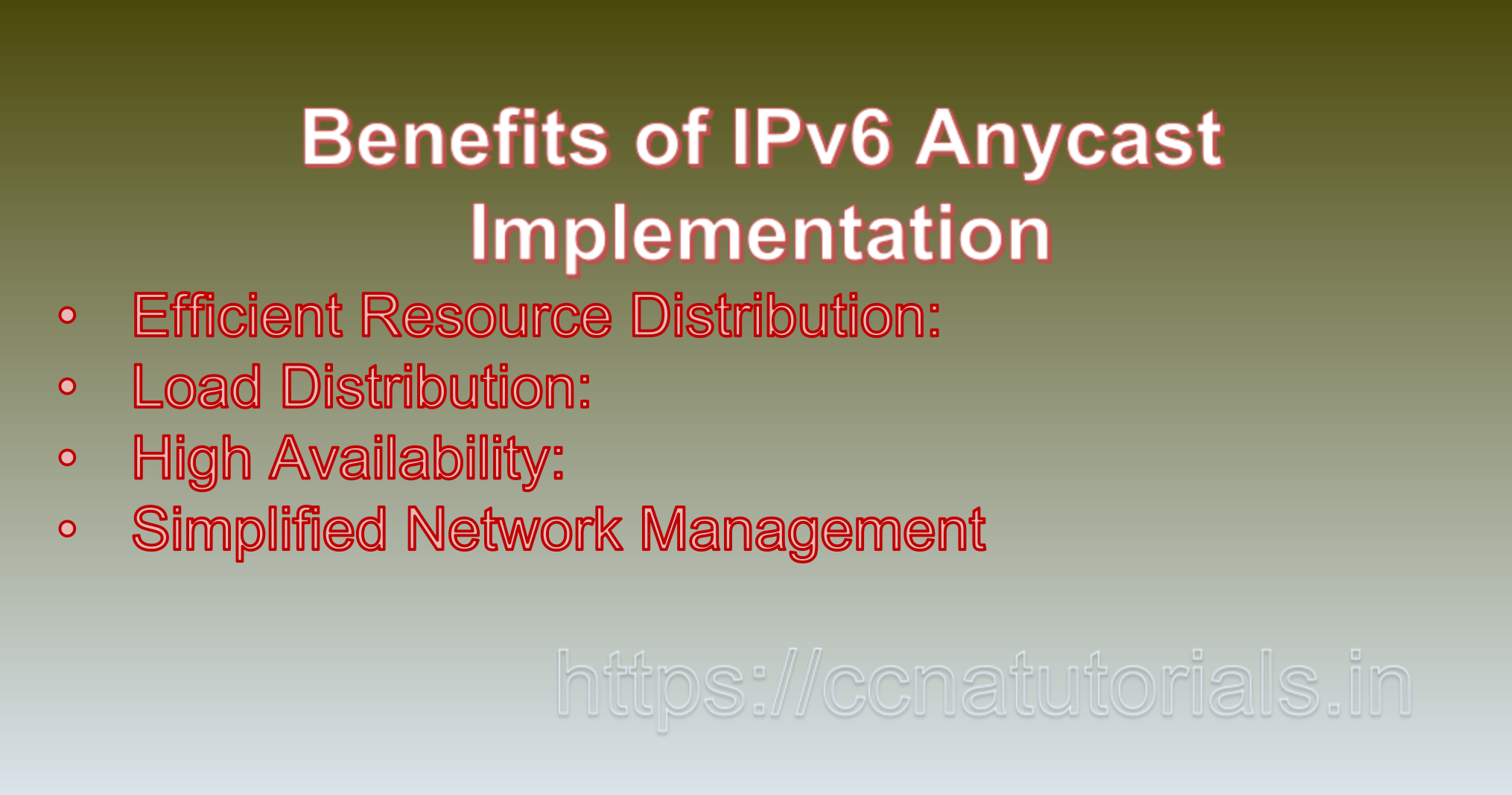Contents of this article
In this article, I describe IPv6 Anycast Implementation: Leveraging Geolocation for Efficient Resource Delivery. IPv6 Anycast is a networking technique that enables multiple devices to share the same IP address, but the data packets sent to that address are routed to the nearest or most optimal device based on network topology. This approach helps distribute traffic and efficiently deliver resources to users by taking advantage of the geolocation of network nodes. In this article, we explore the concept of IPv6 Anycast implementation, its benefits, and provide a real-world example to illustrate its practical application.
IPv6 Anycast Implementation:
1. IP Address Assignment:
In an Anycast implementation, multiple devices are assigned the same IPv6 address. This address is chosen to represent a particular service, resource, or functionality.
2. Routing Configuration:
The devices sharing the Anycast address are geographically distributed across different locations or data centers. The network infrastructure is configured to route packets destined for the Anycast address to the nearest device based on the shortest path in terms of network latency or cost.
3. Packet Forwarding:
When a client sends a request to the Anycast address, routers along the path determine the nearest device using routing metrics like Border Gateway Protocol (BGP) attributes or routing tables.
4. Resource Delivery:
The request is directed to the closest device, ensuring that the user receives the requested resource from the geographically optimal location.
Benefits of IPv6 Anycast Implementation:
1. Efficient Resource Distribution:
IPv6 Anycast ensures that users are directed to the nearest server or resource, reducing latency and enhancing the delivery of services.
2. Load Distribution:
Traffic is automatically balanced across multiple devices sharing the Anycast address, preventing overload on a single server and improving overall system performance.
3. High Availability:
Anycast enhances fault tolerance. If one Anycast node becomes unavailable, the routing mechanism automatically redirects traffic to the next nearest node.
4. Simplified Network Management:
Anycast abstracts the physical location of servers, making it easier to manage resources distributed across multiple geographic locations.
Example Scenario for IPv6 Anycast Implementation:
Consider a global content delivery network (CDN) that hosts popular websites and serves them to users worldwide. The CDN wants to optimize the delivery of its content to users by implementing IPv6 Anycast.
1. IP Address Assignment:
The CDN designates a specific IPv6 address (let’s say 2001:0db8:1234:5678::1) for its Anycast implementation. Multiple servers across different data centers are assigned this address.
2. Routing Configuration:
The CDN configures its routers and BGP advertisements to announce the Anycast address. Each data center advertises the Anycast route with the same prefix but different next-hop addresses.
3. Client Request:
A user in Europe requests a web page hosted by the CDN. The user’s request is sent to the Anycast address (2001:0db8:1234:5678::1).
4. Packet Forwarding:
Routers along the path use BGP metrics to determine the closest data center based on network latency. The user’s request is directed to the European data center with the shortest path.
5. Resource Delivery:
The requested content is delivered to the user from the European data center. The user experiences reduced latency and faster loading times.
6. High Availability:
If the European data center experiences a sudden outage, BGP routing tables are updated, and traffic is rerouted to the next nearest data center (e.g., in North America).
In short IPv6 Anycast Implementation:
IPv6 Anycast implementation is a powerful technique for optimizing resource delivery, enhancing network efficiency, and improving user experience. By allowing multiple devices to share the same IP address while directing users to the nearest or most optimal location, Anycast leverages geolocation for efficient traffic distribution. The real-world example of a global CDN illustrates how IPv6 Anycast can be utilized to minimize latency, ensure high availability, and streamline content delivery on a global scale. As networks continue to expand and user demands grow, IPv6 Anycast offers an effective way to optimize resource delivery and deliver consistent, high-quality services to users worldwide.

IPv6 Anycast Implementation Leveraging Convergence for Efficient Network Services. IPv6 Anycast is a network addressing and routing technique that enables multiple devices to share the same IP address while being located in different geographical locations. Anycast leverages the closest available network node to provide services, enhancing performance, redundancy, and efficient resource utilization. In this article, we delve into the details of IPv6 Anycast implementation, its benefits, and provide real-world examples to illustrate its significance.
IPv6 Anycast Implementation:
1. Identical IP Address:
In an Anycast implementation, multiple network nodes are assigned the same IPv6 address. This address represents a service or resource that is available from different locations.
2. Routing Configuration:
Routing protocols are configured to route traffic destined to the Anycast address. The goal is to direct traffic to the nearest or most optimal Anycast node based on routing metrics.
3. BGP Configuration:
Border Gateway Protocol (BGP) is often used for Anycast implementation. BGP ensures that the routing updates for the Anycast address are distributed to routers, guiding traffic to the nearest node.
4. Network Monitoring:
Continuous monitoring of network nodes and their availability is crucial to ensure optimal Anycast service delivery. Nodes that experience failures are removed from the Anycast group.
Benefits of IPv6 Anycast Implementation:
1. Performance Optimization:
Anycast directs users to the nearest available node, reducing latency and improving response times. This is especially valuable for content delivery networks (CDNs) and critical services.
2. Redundancy and High Availability:
Anycast provides redundancy by allowing multiple nodes to offer the same service. If one node becomes unreachable, traffic is automatically redirected to the next nearest node.
3. Scalability:
Anycast supports the distribution of traffic across multiple nodes, enabling efficient resource utilization and load distribution during peak usage periods.
4. Global Service Delivery:
Anycast allows services to be offered from multiple geographic locations, ensuring consistent performance for users across different regions.
Example Scenarios:
1. DNS Anycast for Global Resolving:
A major DNS provider implements Anycast for its DNS resolution service. The provider assigns the same IPv6 address to multiple DNS servers deployed in different data centers around the world. When a user sends a DNS query to the Anycast address, the request is directed to the nearest DNS server, reducing latency and improving response times. If a specific server experiences issues, BGP routing automatically redirects traffic to the next available server, ensuring high availability and seamless service delivery.
2. CDN Anycast for Content Distribution:
A content delivery network (CDN) utilizes Anycast to distribute content efficiently. The CDN assigns the same IPv6 address to multiple edge servers located in various geographic locations. When users request content, they are directed to the nearest edge server, reducing the distance data needs to travel and improving content delivery speed. Anycast also provides load balancing, ensuring even distribution of traffic across edge servers.
3. Network Services Anycast for Redundancy:
A cloud service provider employs Anycast for network services such as load balancing and firewalling. The provider assigns the same IPv6 address to multiple instances of these services located in different data centers. Anycast directs traffic to the closest available service instance, improving performance and offering redundancy. If a service instance becomes unavailable, BGP routing guides traffic to the next nearest instance, maintaining service continuity.
Conclusion IPv6 Anycast Implementation:
IPv6 Anycast implementation is a powerful technique that enhances the efficiency, redundancy, and performance of network services. By enabling multiple nodes to share the same IP address and directing users to the nearest available node, Anycast optimizes service delivery, reduces latency, and ensures high availability. The examples provided highlight how Anycast is utilized for DNS resolution, content distribution, and network services, demonstrating its practical applications and benefits. As organizations strive to deliver reliable and efficient services to users across the globe, IPv6 Anycast emerges as a valuable tool for achieving these objectives while maintaining a robust and scalable network infrastructure. You may drop a comment below or contact us for any query related to this article.






